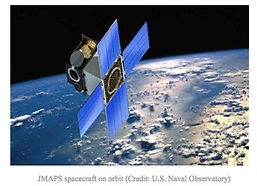US Naval Observatory
Overview
I was a Researcher in the Astrometric Satellite Division on the Department of Defense space mission: Joint Milliarcsecond Pathfinder Survey (JMAPS)- a DoD space mission with the goal of measuring the positions of stars and galaxies to a high precision. First author on 11 refereed JMAPS mission-public Technical Memoranda: astrophysical analyses determining several critical mission requirements. Advanced computer programming in C, MATLAB, IDL, and Python. Presentations bi-weekly for 10-15 PhD's and semi-annually for 50+ PhD's.
I worked directly underneath Dr. Bryan Dorland, Head of the Astrometry Department at the US Naval Observatory and former Chief of the Astrometric Satellite Division.
Technical Memoranda
1) Z. Dugan, "Non-Linearity Centroiding Error Analysis," JMAPS TM 10-04. The effect of non-linear detector response on centroiding error is determined by varying quantum efficiency in simulations as a parabolic function of photon counts. Simulations with different maximum quantum efficiencies and locations over the entire sub-pixel phase space are performed with stars of magnitudes 8-13. Centroiding error caused by non-linearity is less than one milliarcsecond for stars with magnitudes dimmer than 8.5.
2) Z. Dugan, "Sub-Pixel Phase Error Analysis," JMAPS TM 10-03. Comprehensive, two dimensional sub-pixel phase error maps are created to correct for the entire sub-pixel phase space. Various statistics on both the uncorrected errors and post-correction residuals, including standard deviation of the mean centroiding error, as a function of number of observations are reported.
3) Z. Dugan, "Zero Parallax Galactic Stars," JMAPS TM 10-02. Near-zero parallax galactic stars are necessary to tie down JMAPS zonal errors near the galactic plane. O-stars, Wolf-Rayet stars, and K-giants are evaluated as potential candidates. Roughly 1700 K-giants are found to be viable zero parallax stars, and their reduction of parallax zonal error in the final JMAPS block-adjustment solution is simulated.
4) Z. Dugan, "Stellar Distributions as a Function of I-band Magnitude from SuperCOSMOS and a New B-Band Algorithm, " JMAPS TM 10-01. To verify the results of and examine the effects of reddenning in TM 09-06, distribution statistics on 2 sets of 1 million randomly pointed, simulated JMAPS frames are reported as a function of I-band magnitude using SuperCOSMOS data and a new algorithm centered on B-band data as opposed to V-band data.
5) Z. Dugan, "Centroiding Error as a Function of Flat Field and Dark Current Variability," JMAPS TM 09-08. To ensure single milliarcsecond precision astrometry for JMAPS, simulations of variability over flat fields and dark current using Guassian and Poisson random variables are performed to predict centroiding errors as a function of spectral type and magnitude.
6) Z. Dugan, "Stellar Distributions as a Function of I-Band Magnitude, " JMAPS TM 09-06. Distribution statistics on 2 sets of 1 million randomly pointed, simulated JMAPS frames are reported to determine requirements on JMAPS guide stars and science stars.
6) Z. Dugan, "Stellar Distributions as a Function of I-Band Magnitude, " JMAPS TM 09-06. Distribution statistics on 2 sets of 1 million randomly pointed, simulated JMAPS frames are reported to determine requirements on JMAPS guide stars and science stars.
7) Z. Dugan, "Simulated Peak Pixel Rates for 151 Brightest I-Band Stars for Notional Astrometric Telescope," JMAPS TM 08-27. The minimum, median, and maximum count rates for the single brightest pixel on the J-MAPS FPA for each of the 151 brightest stars are calculated, along with the corresponding integration times required to prevent saturation. For further requirement analysis, the count rates of the 151 brightest stars are increased by 25\% and used to determine necessary integration times.
8) Z. Dugan, "JMAPS Guide Stars," JMAPS TM 08-23. To calculate data on the ten brightest stars in a typical J-MAPS frame for instrument requirements, stellar counts from TM 08-12 and photoelectron count rates from TM 08-13 are used to calculate the number of stars, photoelectron counts, photoelectron count rates, signal to noise ratio (SNR), and the single measurement precision (SMP) of stars per JMAPS frame.
9) Z. Dugan, "Astrometric Passband Polychromatic Weighting for Monochromatic Point Spread Functions," JMAPS TM 08-20. To generate realistic, polychromatic PSFs as a function of spectral type and magnitude, high-fidelity monochromatic PSFs generated over separate passbands of the instrument's total spectral response region are superimposed according to weights calculated from each spectral type.
10) Z. Dugan, "Estimated JMAPS Count Rates," JMAPS TM 08-13 . The anticipated photoelectron count rates generated on the H4RG Hybrid Complementary Metal-Oxide Semiconductor detector from stars with spectral types O5 to M6 and apparent visual magnitudes 0 to 16 are calculated using the zero point flux density for the Johnson V-band, the spectra of the main sequence stars, and the spectral throughput of the JMAPS optical system.
11) Z. Dugan, "Star Counts and Photometric Parallaxes as a Function of Spectral Type and V-band Magnitude," JMAPS TM 08-12 . Using B and V-band photometry from NOMAD, both raw counts and relative percentages of each spectral type per magnitude are calculated, as well as the average distance and parallax of each spectral type per magnitude to provide JMAPS with an enhanced understanding of potential stars to observe.










